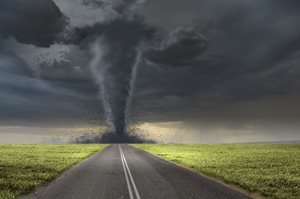(4/12/2021)
Spring is here, and so is a new tornado season in the United States, with predicted above-average tornado activity. On March 26, 23 tornadoes were reported across Alabama, Georgia, and Mississippi, causing 5 deaths and devastating destruction. Healthcare facilities must not only be prepared to keep patients, staff and visitors safe during a tornado, but must also be equipped to receive a surplus of victims from any disaster, as these locations often serve as safe havens in their communities. Every year, weather-related disasters lead to approximately 500 deaths and result in $15 billion in damages. By maintaining an environment safe from tornadoes, hospitals can focus on what’s most important – treating patients.

La Niña, a weather pattern that occurs in the Pacific Ocean, often contributes to an uptick of severe thunderstorms and tornadoes across the U.S., and that will be no different this March through May. This is concerning as tornado activity has
already increased in recent weeks, and some of the country's most severe tornado outbreaks, like the devastating 2011 tornado season, have happened during La Niña events.
Tornadoes can wreak havoc in an instant, therefore its crucial facilities have updated emergency plans specific for tornadoes and all associates are trained to respond quickly in this situation. It can be a challenge to respond in a timely manner if a plan isn’t in place well in advance.
Implementing a comprehensive tornado plan involves more than just putting it on paper, but also regularly practicing the emergency response and re-evaluating areas where it may be lacking. It seems like a simple process, but without regular training and exercises, leadership teams may respond inadequately, resulting in unforeseen circumstances. Plans should include considerations such as pre-landfall actions, safe shelter locations, accountability procedures, horizontal and vertical evacuation, building damage assessment, and training practices.
Making sure that disaster response supplies are accessible is also critical to treating patients during an emergency. For example, during the 2013 Joplin, Missouri tornado, disaster equipment became inaccessible as it was stored in a singular location. Storing supplies in multiple locations and ensuring they are accessible if areas of the hospital become damaged is a successful strategy.
Developing a strong communication infrastructure is also important, as tornadoes can often impact the reliability of these resources. If infrastructure is damaged, alternatives should be in place such as satellite phones, HAM radios, and mass notification systems. Remember that having a unified message and clear communication will prevent miscommunications, especially with social media often spreading false information quickly during disasters.
Hospitals should employ a dedicated public information officer to coordinate these updates and create plans for internal team member communication. There should be plans for every scenario – from power outages to tornado destruction.
Being underprepared to withstand a tornado can result in loss of community trust and the loss of lives. It’s imperative that your healthcare facility is prepared to respond to tornado reports swiftly and effectively.
Want to learn more about Medxcel and our emergency management services? Contact us at
info@medxcel.com or 855-633-9235.